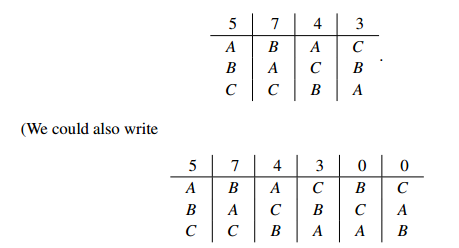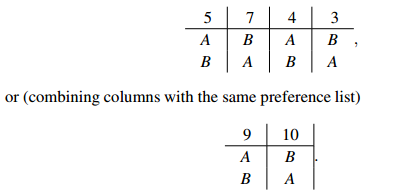

تاريخ الرياضيات

الاعداد و نظريتها

تاريخ التحليل

تار يخ الجبر

الهندسة و التبلوجي


الرياضيات في الحضارات المختلفة

العربية

اليونانية

البابلية

الصينية

المايا

المصرية

الهندية


الرياضيات المتقطعة

المنطق

اسس الرياضيات

فلسفة الرياضيات

مواضيع عامة في المنطق


الجبر

الجبر الخطي

الجبر المجرد

الجبر البولياني

مواضيع عامة في الجبر

الضبابية

نظرية المجموعات

نظرية الزمر

نظرية الحلقات والحقول

نظرية الاعداد

نظرية الفئات

حساب المتجهات

المتتاليات-المتسلسلات

المصفوفات و نظريتها

المثلثات


الهندسة

الهندسة المستوية

الهندسة غير المستوية

مواضيع عامة في الهندسة

التفاضل و التكامل


المعادلات التفاضلية و التكاملية

معادلات تفاضلية

معادلات تكاملية

مواضيع عامة في المعادلات


التحليل

التحليل العددي

التحليل العقدي

التحليل الدالي

مواضيع عامة في التحليل

التحليل الحقيقي

التبلوجيا

نظرية الالعاب

الاحتمالات و الاحصاء

نظرية التحكم

بحوث العمليات

نظرية الكم

الشفرات

الرياضيات التطبيقية

نظريات ومبرهنات


علماء الرياضيات

500AD

500-1499

1000to1499

1500to1599

1600to1649

1650to1699

1700to1749

1750to1779

1780to1799

1800to1819

1820to1829

1830to1839

1840to1849

1850to1859

1860to1864

1865to1869

1870to1874

1875to1879

1880to1884

1885to1889

1890to1894

1895to1899

1900to1904

1905to1909

1910to1914

1915to1919

1920to1924

1925to1929

1930to1939

1940to the present

علماء الرياضيات

الرياضيات في العلوم الاخرى

بحوث و اطاريح جامعية

هل تعلم

طرائق التدريس

الرياضيات العامة

نظرية البيان
Voting Systems-Sequential Voting
المؤلف:
W.D. Wallis
المصدر:
Mathematics in the Real World
الجزء والصفحة:
170-172
16-2-2016
1681
Another technique used to avoid the problems of the plurality method is sequential voting. In this scheme a vote is taken, as a consequence a new set of candidates is selected; then a new vote is taken. The aim is to reduce the set of candidates to a manageable size—often to size two. The original election is again called a primary, but in this case all the candidates run in the primary election, not just those in one party.
For example, when the President of France is to be elected, there is a primary election for all the candidates. Each voter can select one candidate, and the numbers of votes for each candidate are counted. Later there is another election; there are two candidates, the two candidates who received the most votes in the primary. This second (runoff) election is decided by the majority method. A similar method is used in electing the President of the Ukraine, and in a number of other situations.
We shall refer to this as the runoff method or plurality runoff method. The two top candidates are decided by plurality vote; all other candidates are eliminated; then a majority vote is taken.
In the real world, the preference list is not fixed. There is usually a delay after the primary, and more campaigning takes place. As a result of this the preference lists may change. But for simplicity’s sake we shall ignore this for the moment, and assume that every voter has an order of preference between the candidates that remains fixed throughout the voting process. We define the preference profile of an election to be the set of all the voters’ preference lists. This can conveniently be written in a table. For example, say there are three candidates, A, B, C, and suppose:
5 voters like A best, then B, then C;
7 voters like B best, then A, then C;
4 voters like A best, then C, then B;
3 voters like C best, then B, then A;
no voters like B, then C, then A;
no voters like C, then B, then A.
We can represent this as

but we shall usually omit zero columns.)
In the primary election, each elector votes for the candidate he or she likes best.
In the example, A would receive nine votes—five from those with preference list ABC, and four from those with list ACB. In general, a candidate receives the votes of those who put that candidate first in the preference list. Then the two candidates with the most votes go on to the main election. To work out the votes, you could delete all the other candidates from the electors’ lists, so that everybody has a list with just two members. And remember, in the real world, some electors will change their preferences before the runoff election.
Sample Problem 1.1 Suppose the preference profile of an election is

What is the result of the election in the following cases?
(i) The majority method is used.
(ii) The plurality method is used.
(iii) The runoff method is used.
Solution. A receives nine votes, B receives seven, C receives three. So (i) there is no majority winner (as there are 19 voters, 10 votes would be needed), and (ii) A is the plurality winner. In a primary election, A and B are selected to contest the runoff. For the runoff, C is deleted, and the preference profile becomes

So B wins the runoff.
Modifications of this method are also used. When the city of Carbondale, Illinois, elects its Mayor, there is a primary election when there are more than four Mayoral candidates. In the final election, the candidates are the four original candidates who received the most primary votes, and the plurality method is used.
 الاكثر قراءة في الرياضيات التطبيقية
الاكثر قراءة في الرياضيات التطبيقية
 اخر الاخبار
اخر الاخبار
اخبار العتبة العباسية المقدسة

الآخبار الصحية















 قسم الشؤون الفكرية يصدر كتاباً يوثق تاريخ السدانة في العتبة العباسية المقدسة
قسم الشؤون الفكرية يصدر كتاباً يوثق تاريخ السدانة في العتبة العباسية المقدسة "المهمة".. إصدار قصصي يوثّق القصص الفائزة في مسابقة فتوى الدفاع المقدسة للقصة القصيرة
"المهمة".. إصدار قصصي يوثّق القصص الفائزة في مسابقة فتوى الدفاع المقدسة للقصة القصيرة (نوافذ).. إصدار أدبي يوثق القصص الفائزة في مسابقة الإمام العسكري (عليه السلام)
(نوافذ).. إصدار أدبي يوثق القصص الفائزة في مسابقة الإمام العسكري (عليه السلام)


















